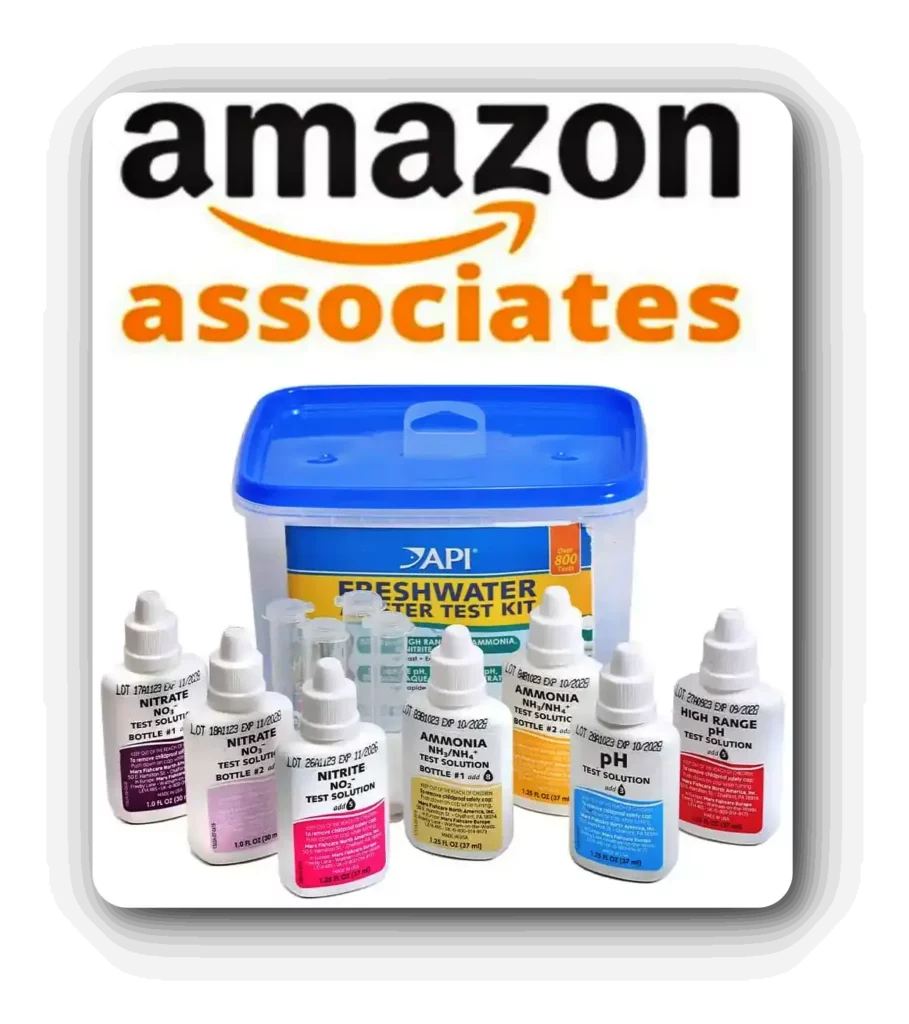This is your one-stop guide to everything on Oranda Goldfish, including care tips, its varieties, and tank setup.

Introduction to Oranda Goldfish
You can’t bypass the Oranda goldfish if you’re building an aquarium with interesting goldfish varieties.
The Oranda’s characteristics are striking from a distance. You’d notice their hooded bubble heads, short bodies, and long, elegant fins. Although this aquarium fish typically has a bright orange tone, some species come in black and white colors.
Beyond these physical features, there are 1,001 more reasons to add Oranda goldfish to your aquarium, and this guide will tell you. I’ve also included a brief history with tips on setting up a tank and breeding the Oranda goldfish. So, without wasting time, let’s get to business!
History and Origin
The Oranda goldfish’s history starts in ancient Asia, where aquarists perfected the art of breeding goldfish from wild carp and other species creating the beautiful aquatic pets we know today.
Although the Chinese goldfish is as old as 1,000 years, the Japanese goldfish existed only about 200 to 400 years ago.
This short origin story explains why some Oranda goldfish have the common orange scales of other types of the species, and others have unique white/black colors. How can you separate the Oranda from other kinds of goldfish?
The origin of the Oranda goldfish explains its similarities to other goldfish, such as its orange scales or the unique white and black colors some have. The cross between the
Physical Characteristics
Physical characteristics including their iconic colors and body shape are the quickest way to identify different fish species. The Oranda goldfish’s appearance is unique because of its head growth – the wen. It has a small hump on its head that forms a hood-like shape, almost covering its eyes.
Meanwhile, the Oranda goldfish’s body is short and round, unlike most of its counterparts, which are streamlined. This short body doesn’t affect its fin, though. Both the tailfin and body fins are long and wide.
The orange and gold color pattern is the most popular scale tone for Oranda goldfish, but it’s not the only one. There are also white and black, unique to the Japanese-bred species, with more white scales and few black spots.
Besides the goldfish’s physical traits, you can also identify different species by their temperaments. I’ll explain that in detail soon, but first, let’s sneak a peek at the types of Oranda goldfish.
Types of Oranda Goldfish
If you want to fill your aquarium with only Oranda goldfish breeds, there are many options to explore. Physically, they’re the same size and shape, but their colors and fins aren’t the same. Here’s a brief insight into each one of them:
Red Cap Oranda Goldfish
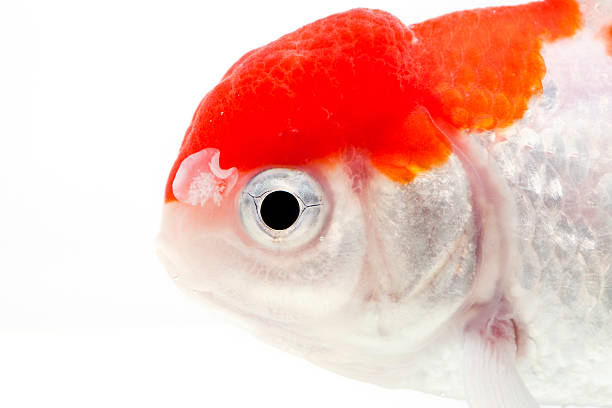
The Red Cap Oranda got its name from its bright reddish-orange wen covering its head. This color is often darker than the rest of the body and sometimes different from the body’s hue. You can see a Red Cap Oranda with a white body!
Red Oranda Goldfish (Orange Oranda)
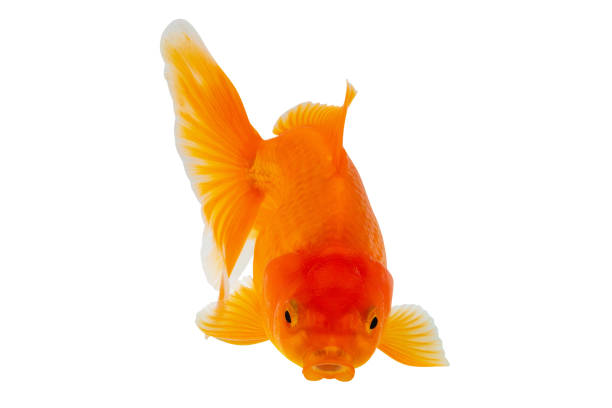
The red/orange Oranda goldfish has a single reddish-orange scale tone that may appear purely red or orange. This color is the same on its wen and body.
Blue Oranda Goldfish

If you’ve ever seen an Oranda goldfish with a metallic blue color, you’ve met the Blue Oranda goldfish. It’s a rare variant of this species, making it a certified star in any aquarium. There’s no exact shade of blue as it ranges from deep to light and sometimes both.
Panda Oranda Goldfish

Unlike the unique white Red Cap Oranda, the Panda Oranda goldfish is white and black, like a panda bear. That’s including its wen.
Calico Oranda Goldfish
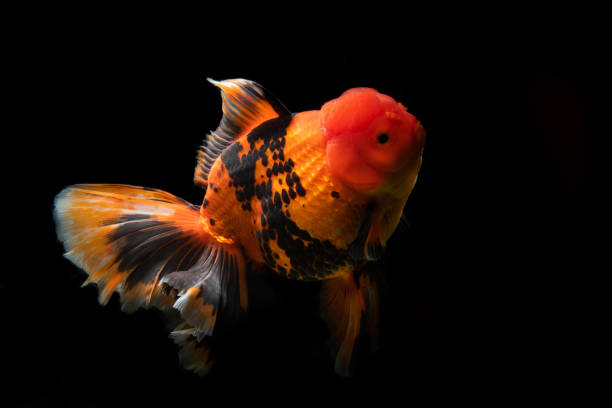
Calico Oranda goldfish are another rare color of this aquatic breed. They result from breeding multiple types of oranda, allowing them to display a combination of colors from other pure breeds. You’d often see the Calico Oranda with black, white, red, and orange patches.
Now, let’s set up your ideal Oranda goldfish tank.
Ideal Tank Setup
An ideal Oranda Goldfish tank setup has the perfect water parameters, filtration system, and decorations in the right tank size. I’ll take each feature individually to give you a clear understanding of what you’re to do.
Tank Size
Choosing the right tank size is the first step in your aquarium setup because your Oranda goldfish need ample space to move without hurting their wen or fins. An average-sized Oranda goldfish will grow up to 12 inches while retaining a sizable 8-inch at its smallest.
If you have multiple Oranda goldfish in your aquarium, you’ll need a tank that holds up to 30 gallons of water or more. This large space allows all the fish in the tank to move without fighting for space, harming themself, or getting aggressive.
Water Parameters
Keep your water temperature at 65°F – 72°F to maintain a cool ecosystem because Oranda goldfish are meant for cold waters. Don’t allow the pH level to rise higher or lower than 7.0 – 7.6, also maintain a hardness of 4 – 12 dGH.
The best way to maintain livable waters for your Oranda goldfish is through maintenance. Change your tank water weekly and vacuum the substrates. That’s why you need decor that’s easily cleanable.
Without maintaining proper water parameters, the tank’s water quality can degrade, which can cause a wide range of issues from cloudy aquarium water to illness and mass fish die off.
Filtration System
Oranda goldfish produce a lot of waste from feeding, which can lead to high levels of ammonia. But you can prevent this by installing a good filtration system in the tank. The filters will sift the waste from the water to maintain its quality.
When choosing a filter, pick a great filtration system that works double time. It should clean your water within an hour without getting overwhelmed.
Decorations
Your aquarium setup needs beautiful decor to improve its aesthetic value, but be careful. Don’t select decorations that’ll hurt your Oranda goldfish while they move. Instead, choose soft and smooth substrates like sand and gravel.
You can add small rocks and driftwood with artificial plants that won’t stab at the Oranda’s wen when it hides. Also, prioritize easy-to-clean decor because when your pets mess up the water, it’s due to their messy feeding habits.
Author’s Note: For some planted tank decor tips check out our article on The 8 Best Live Plants for Goldfish Aquariums, there are indeed live plants that can thrive in a goldfish habitat!
Feeding and Diet
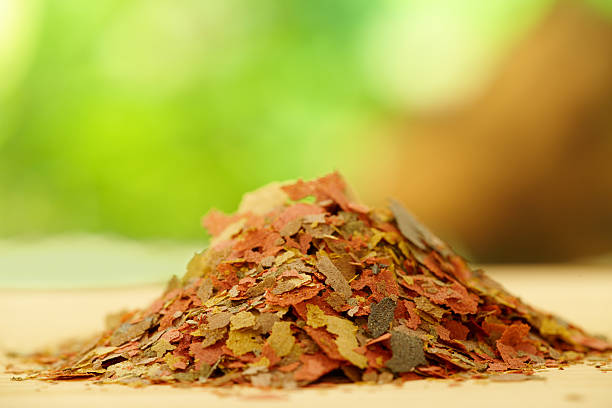
Firstly, I’ll explain this fish’s dietary needs to help you understand their feeding habits.
Dietary Needs for Oranda Goldfish
Oranda goldfish need a balanced diet containing protein, minerals, fats, and vitamins. We recommend feeding these Gold Fish Pellets:
You can introduce these dietary needs with specially formulated goldfish food made into pellets and flakes. Or you can curate your goldfish nutrition by making food from blanched vegetables, frozen bloodworms, and brine shrimps.
When you feed your Oranda goldfish vegetables, ensure it’s not one treated with pesticides. That will be harmful to their overall health.
Whether you buy commercial food or make your own, the goal is to feed your Oranda goldfish with a balanced diet.
For more on feeding your aquatic pets check out The Ultimate Guide to Fish Food: Pros and Cons & Best Choices!
Feeding Oranda Goldfish
Always feed your Oranda goldfish in small portions, even though they need to be eaten multiple times daily. It’s best to serve them three to four times daily than to pile them in one feeding session.
Whatever portion you feed your pets must be something they can finish within 5 to 10 minutes. If not, they’ll overeat and leave the excess in the water, causing ammonia waste and poisoning. They may also become obese and develop breathing health issues.
Health and Common Disease
Speaking of health issues, here are some common goldfish diseases your pet may encounter if you don’t maintain good water quality and watch their feeding:
Lateral Line Erosion
Your Oranda goldfish may get a hole in the head from injuring their wen. It could also result from a poor diet, especially a lack of vitamins or negligent goldfish care. If you don’t maintain high-quality water parameters, parasites will grow in the tank and harm your fish.
Also, when you keep multiple Oranda goldfish in small tanks, you’ll cause them stress, which can manifest as a hole in the head.
Treatment: Add vitamin supplements to your Oranda goldfish’s diet and pay extra attention to the water quality.
Anchor Worms
When you see worms from your Oranda goldfish’s body and notice them displaying signs of irritation such as restlessness, they could have Anchor worms. Anchor worms are parasites that feed on goldfish. They come from contaminated water and live food.
Treatment: Visit a veterinarian. But if you don’t have time, you can try home care. First, remove the worms from the fish’s body. Then, get parasitic medication from the nearest aquatic life pharmacy.
Fungal Infections
Low water quality, a weak immune system from poor diets, and injuries can lead to fungal infections. As a sign of this illness, you’ll notice your Oranda goldfish’s body growing cotton-like patches.
Treatment: Get antifungal medication immediately. But also treat the root cause.
Change your Oranda goldfish’s diet to include proper nutrition. Clean the water and ensure it’s in the right parameters. Finally, ensure enough space for movement so the fish isn’t stressed while swimming.
Fin Rot
Bacterial infections from poor water and untreated injuries can manifest as rotting fins. You’ll notice erosions around the fin’s edges and discoloration.
Treatment: Use antibiotics and antimicrobial medication depending on your pharmacist’s prescription. You can also use a good dietary plan to revive your Oranda goldfish’s immune system.
Swim Bladder Disease
Watch how your Oranda goldfish swims. It’s supposed to swim with its head up and at a sensible water level. But when the pets start sinking to the bottom of the aquarium or floating on one side, it’s time to worry.
Swim bladder disorder occurs when the Oranda goldfish gets bloated or constipated from overfeeding. It can also occur when they struggle to gulp air when feeding due to contaminated water or poor oxygen flow.
Treatment: Add fiber to the fish’s diet after reducing its meals or stopping them for at least one to two days. Keep the water parameters at an optimal level.
Preventing Common Diseases
These are common illnesses for all goldfish and not just the Oranda species. So, there are uniform disease prevention methods you can use.
- Maintain Water Quality
- Monitor Your Fish: Make it a habit to monitor your fish daily. Observe their patterns and behaviors to spot differences immediately as they happen.
- Feed your goldfish with proper goldfish nutrition.
- Quarantine New Fish: When introducing new fish into your aquarium tank, always keep them separately first. This quarantine period ensures they’re healthy and do not risk contaminating the existing Oranda goldfish.
- Test your water using a master test kit frequently.
Breeding Oranda Goldfish
Let’s discuss breeding Oranda goldfish in detail. To make it easy, I will divide the process into five steps.
Step One: Choose Your Breeding Stock
Depending on your patience, you may breed adult or young Oranda goldfish. If you’re going for grown fish, choose 2 – 3 year old stock. The males will have slimmer bodies with white spots on their gill covers and pectoral fins, showing they’re ready for breeding.
When selecting, observe their wen, color, and body to ensure that you pick only the best.
Step Two: Prepare Your Breeding Tank
I recommend getting a separate tank for breeding goldfish, not just Oranda goldfish. You don’t want to endanger your eggs by mixing them with adult fish. This tank should hold 20 – 30 gallons of water and have a gentle filter.
Add soft spawning mops or smooth substrate to provide soft landings for the eggs when they arrive.
This is the stage to start conditioning your new fish for life in the main tank. If they’re adult Oranda goldfish, feed them the same diet as their counterparts in the living tank. But adjust the water parameters to match the breeding conditions of the Oranda goldfish.
Instead of 65°F – 72°F, raise the temperature to 70°F – 74°F.
Step Three: Spawning
Goldfish reproduction is unique. The male Oranda goldfish chase the females to spawn their eggs for fertilization.
Sometimes, a female may not be ready for spawning, even if the male chases. In that instance, ensure your tank has a good hiding spot for her until she’s ready.
Step Four: Egg Care
Collect the eggs immediately after spawning to prevent the parents from eating them. Keep the fertilized eggs in the prepared breeding tank and reduce the lighting to maintain a dark environment.
When the eggs start hatching, watch them for 4-7 days. Once they hatch, the fry eats the yolk from their sacs.
Step Five: The Fry
After eating their yolk sacs, it’s time to feed your Oranda fry with proper food. You can give them infusoria or commercial fry food. Once they start growing, switch to crushed flakes or powdered food for easy digestion.
Feed the Oranda fry half the quantity for a mature one. Watch their growth and ensure bigger ones don’t prey on smaller fry. So, once they start getting robust, you can move the fry to the main tank.
Behavior and Compatibility
Please don’t get confused by the potential of an Oranda goldfish to eat its young as an indication of aggression. That’s far from the truth. In fact, Oranda goldfish behavior makes them great tank mates. They’re gentle and calm swimmers.
If you want to add them to a large group or as the other of a pair, go for it. They only become rowdy when it’s time to feed but aren’t territorial.
Another aquarium fish behavior you’d love from your Oranda goldfish is its enthusiastic swimming. This species will get to the surface and dive to the bottom of your tank, keeping you engaged.
When they dive to the bottom of the tank, Oranda goldfish often forage for food, and when they swim to the surface, they gulp air.
Oranda Goldfish Compatibility with Other Fish
- Other Goldfish: Pair Oranda goldfish with other fancy goldfish with calm temperaments. Examples are Fantails and Ryukins. But don’t pair them with active goldfish like the Comet and Common goldfish, which are competitive during feeding.
- Other Species: You can pair your Oranda goldfish with other bottom dwellers like Nerite Snails and Corydoras Catfish. They can also share a tank with calm, coldwater fish.
Conclusion
Another fun session analyzing goldfish maintenance and care is over. After reading this guide, you should be excited about adding the Oranda goldfish to your aquarium. Here’s a quick refresher on why Oranda goldfish care is a stress-free decision:
- They come in a variety of colors.
- They’ll survive on a balanced diet.
- Breeding takes a week to two weeks.
Keeping Oranda goldfish will make your aquarium hobby even more interesting, especially when they recognize you as their owner. Yes, the Oranda is an interactive fish, so why not add it to your collection?


